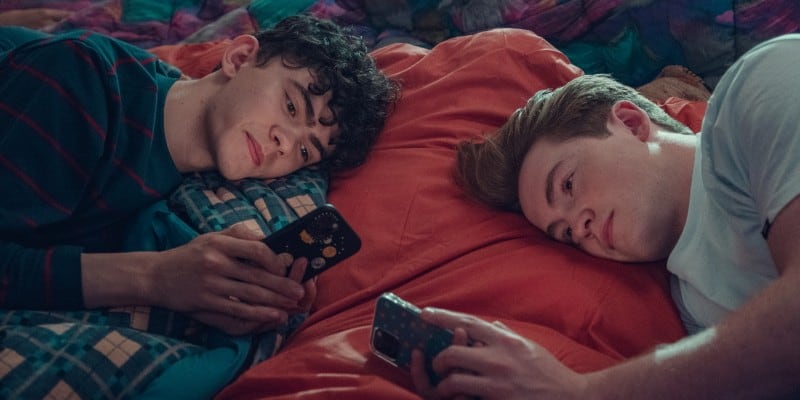
Welcome to Previously On, a column that is keeping an eye on the latest returning TV shows. In this edition, Valerie Ettenhofer reviews season 2 of Netflix’s Hearstopper.
Heartstopper understands that sometimes modern love stories play out one text at a time. The second season of Netflix and Alice Oseman’s super-sweet coming-of-age romance series opens with teen Charlie (Joe Locke) texting his brand new boyfriend Nick (Kit Connor), a smile on his face and a pep in his step. The season keeps that cheerful vibe going throughout its next eight episodes, as graphic novel-inspired Heartstopper for the most part seems to be designed to feel like an ultra-cute daydream. The show’s second season isn’t quite as perfectly structured as its first, and at times its commitment to being adorable strains credulity, but Heartstopper is still an achingly sincere young adult romance with plenty to offer – especially for younger fans.
Season 2 of the series picks up almost exactly where the first left off, with sporty Nick and sensitive Charlie officially dating – and the former planning to come out to friends and classmates soon. As with season 1, the show’s best feature is the care and nuance with which it examines the idea of coming out, presenting it through a realistic lens that’s different for each person and situation. Explaining who you are to people who might not understand can be painful, no matter how confident you are, and much of the new season traces that pain to its heart. While Nick is frustrated with himself each time he hesitates to speak up, Charlie quietly develops issues with food that coincide with both his anxiety over Nick’s well-being and his own past relationship trauma. Meanwhile, best friends Tao (William Gao) and Elle (Yasmin Finney) navigate their own changing relationship.
As season 2 unfolds, the central friend group blossoms into a constellation of cool and geeky queer kids, and the show presents their experiences with an earnestness that’s both heartwarming and, at times, overly optimistic. The show addresses topics like queerness, asexuality, anxiety, eating disorders, emotional abuse, parental neglect, and homophobia in great depth, but in a few key ways, its portrayal of queer awakening seems unwilling to go beyond the surface level. Every relationship in the series starts and ends with kissing, so there’s never any talk about safe sex (although one parent gives an extremely brief abstinence lecture). In the case of trans artist Elle, her experiences facing transphobia as a woman of color are also glossed over in comparison to the ample screen time devoted to the cis white boys’ problems with homophobic bullies. There’s nothing overtly wrong with these narrative choices, but the show’s omissions in key areas result in a strange tonal mix of sharply written emotional realism and rose-colored-glasses fantasy.
Still, as much as Heartstopper toes the line between cute and cutesy, in some ways it feels like an antithesis of a couple of decades’ worth of coming-of-age stories focused largely on cringing moments of embarrassment, casual cruelties, and horny misadventures. There’s a gauzy softness to these love stories (in addition to the two aforementioned couples, the season also spotlights lesbian couple Darcy and Tara, played by Kizzy Edgell and Corinna Brown) that’s almost rebelliously comforting, even as the show attempts to tackle some tough issues. Heartstopper season 2 takes its very teen-specific plotlines seriously, treating hickeys, groundings, and homework procrastination with as much sincerity as any number of more grown-up plotlines. The streaming era seems to be oddly light on tween-friendly shows the whole family can enjoy (think: The Wonder Years, Sister Sister, or Boy Meets World, back when we had cable), but Heartstopper fits pretty neatly into that demographic slot.
Heartstopper’s dreaminess extends to its aesthetics, as the show adorns itself with small, impressionistic animations. When crushes brush hands, we might see literal sparks fly or fall leaves (the graphic novels’ signature motif) twirl in the wind. When a character returns to an unhappy home life, a dark cloud casts a shadow over the doorstep, while test anxiety is presented with a series of frantic scribbles taking over a piece of paper before bleeding outside its edges. These touches are unique and serve as great connective tissue to the show’s source material, to which the season adheres fairly closely.
Both lead actors are clearly talented, and the show gives them a lot to work with this time around, particularly when it comes to Charlie’s issues around food. Rarely have I ever seen a series present eating disorders in such a realistic way; instead of relying on cliche signifiers or melodramatic confrontations, the show takes a nuanced and subtle approach to the topic, showing how disordered eating creeps up on Charlie like a bad habit – and is soothed in part by loving support. In general, the show’s message seems to be that love is a balm that heals whatever ails us and that the most fulfilling relationships can help make up for past deficits of love and care. These may be simple lessons, but they’re ones that are tough to learn at any age. Kids and young adults are lucky to have Heartstopper to teach them – in the gentlest way possible.
Heartstopper season 2 is currently streaming on Netflix. Watch the season trailer here.
Related Topics: Heartstopper, Previously On

